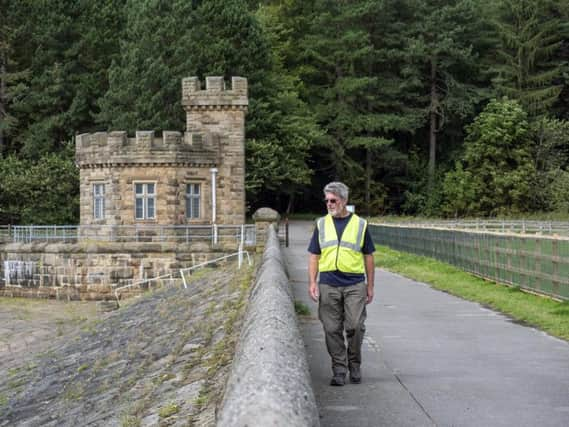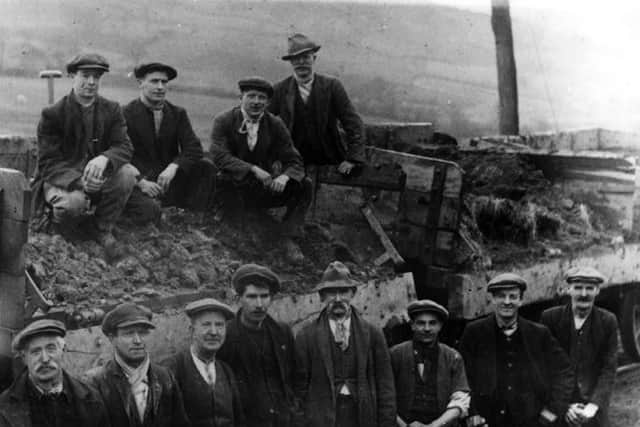Take a tour of two South Yorkshire reservoirs with a remarkable history through the Heritage Open Days


A stone’s throw from the hustle and bustle of the Steel City’s busy suburbs, this lush valley is a gateway to this northern stretch of the Peak District that forms a natural barrier between Sheffield and Manchester on the other side of the Pennines.
It’s where the Broomhall and Morehall reservoirs form a dramatic focal point.
Advertisement
Hide AdAdvertisement
Hide AdAn epic movie about tribal Iron Age Britain is going to be filmed in YorkshireBut, tranquil as they seem to the walkers drawn to the valley by its pleasant paths and attractive woodlands, these two huge bodies of water represent one of the biggest construction projects Sheffield has ever seen, from the building of the reservoirs and dams to fixing the serious problems that emerged to put the scheme in jeopardy.


Mike Atkinson, a former engineer who carried out work on Broomhead Reservoir during his career, is leading a tour of the valley on September 21 as part of Sheffield’s Heritage Open Days festival – proving that history can be found in all manner of places.
“I know a fair bit about what went on with the dams, their construction and some of the problems and associated works,” he says. “I thought ‘I know that, but how many other people do? Let’s put it together and spread the knowledge’.”
The case for building the reservoirs was first made by the city corporation in the late 1800s when, Mike says, Sheffield was running decidedly short of water.
Advertisement
Hide AdAdvertisement
Hide Ad“There just wasn’t enough. The city was developing and growing, and there was a need for more as they saw it, which was quite correct.”
The devastating cholera epidemic in 1832, which killed 400 people in Sheffield, also demonstrated the necessity for reliable, clean water.
“In the early and mid-1800s, very few people had running water,” Mike says. “They certainly didn’t have flushing toilets, which came in over the century in the Victorian era.”
After much legal wrangling with Barnsley and Holmfirth over who owned rights to the hills, construction began in 1913. Broomhead was designated as a ‘supply’ reservoir and Morehall as a ‘compensation’ store, aimed at topping up the nearby Ewden Beck and River Don during dry periods.
Advertisement
Hide AdAdvertisement
Hide AdA railway line was built, and the beginnings of a temporary village for workers, but World War One interrupted and no further progress was made until 1920.
It would have been a monumental venture, says Mike, involving ‘hundreds, possibly even a thousand or two’ workers engaged in ‘hard and dangerous’ toil with no modern equipment.
“They’d got steam shovels, steam cranes and that sort of thing, but there was a lot of heavy manual work,” he says. “There was no health and safety – people turned up in their trousers, shirt, waistcoat and a cloth cap.
The true stories of the Yorkshire dams that collapsed and killed hundreds of people“There were no hard boots, no hi-vis, no helmets and gloves or anything like that unless you supplied them yourself – and you didn’t, because you couldn’t afford to.”
Advertisement
Hide AdAdvertisement
Hide AdHe has not researched how many accidents or fatalities occurred but would guarantee that some lost their lives.
“Every construction site in that era had deaths, it was just a case of how many, how serious and, in some cases, who could be held to blame.”
In 1924, workers noticed that the hillside towards Yewtrees Lane, north of the Broomhead site, began slipping as an important overflow channel was being dug.
“They realised they needed to do something,” says Mike. “They were digging the channel and the ground kept coming towards them.”
Advertisement
Hide AdAdvertisement
Hide AdA trench was dug in short lengths and a drain up to 50 feet deep was put in, filled with rubble.
“That, together with removing 400,000 cubic yards of soil from the top end of the slip, seemed to stop the movement,” Mike says.
The then minister of health, Arthur Greenwood, cut the ribbon in 1929, marvelling at the two reservoirs reported to have a total capacity of 1,618 million gallons of water.
But the problems still hadn’t been solved. More ground movement was detected after Broomhead was filled, along with cracks in the overflow channel and valve tower. Extra drains were required, the whole hillside was remodelled and another 160,000 cubic yards of soil was taken away.
“If these problems hadn’t been
dealt with they wouldn’t have had
an overflow,” Mike explains. “If we
look at it now, with modern
Advertisement
Hide AdAdvertisement
Hide Adknowledge, we’d immediately recognise there was a problem. But then, the geological and engineering knowledge of soil and rocks was far less than
now.”
The landslip has been monitored ever since. It is reputed that the remedial works cost just as much as the basic cost of both reservoirs.
Similarly, the rebuilding of the
dam wall that partially collapsed
this summer at Toddbrook Reservoir
in Whaley Bridge, Derbyshire, is predicted to run into millions of pounds.
Mike says last month’s emergency in the High Peak threw into sharp relief the feats of engineering required to deliver water to people’s homes.
Advertisement
Hide AdAdvertisement
Hide Ad“We think about the gas and electricity because we pay for it by the unit. A lot of people still pay for their water as a proportion of the council tax, or rates. Only when you start paying by the cubic metre for your water do you think how vital a resource it is. It’s really more vital than electricity and gas. It’s just a personal opinion, but I think people undervalue the water we take for granted – turn on the tap and it’s always there.”
How Calderdale’s reservoirs can be secret new weapon in flooding fight if law is changed – Holly LynchWilliam Terrey, general manager of the Sheffield Corporation Waterworks Department until 1929, administered the work on Broomhead and Morehall, which are now maintained by Yorkshire Water.
Terrey died in 1935, and his obituary attributed to him the ‘recognised exceptionally high standard’ of Sheffield’s supply.
Mike agrees that the city’s water makes a very good cup of tea – but says the answer lies more with geology.
Advertisement
Hide AdAdvertisement
Hide Ad“We haven’t got water coming through, say, limestone rock. A lot of the Sheffield water is runoff from the moors – it wants a bit of cleaning up for peat debris and taking the colour out of it... but strictly little more needs to be done with it.”
The walk on Saturday, September 21, starts at 10am and finishes at 3pm. It is also included in the Sheffield Walking Festival programme - see www.theoutdoorcity.co.uk/sheffwalkfest for details.
Heritage Open Days run from September 13 to 22 with more
than 130 events in Sheffield. See www.heritageopendays.org.uk for details.